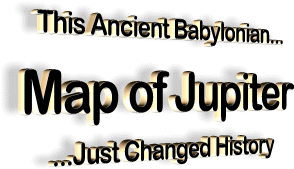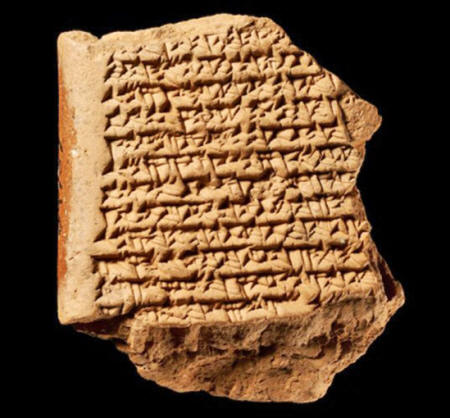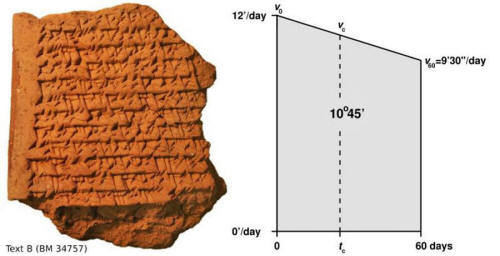|

by Arjun Walia
January 29, 2016
from
Collective-Evolution Website

A historian has just decoded a
mysterious trapezoid from ancient Babylonian astronomical tablets.
After analysis of the tablet, it has
been concluded that Babylonian astronomers had calculated the
movements of Jupiter using an ancient form of geometric calculus.
Keep in mind that this is approximately 1500 years before we thought
this type of math was invented by the Europeans.
The tablet was translated by astro-archeologist
Matthieu Ossendrijver of Humbolt University in Berlin.
As
Science Alert points out:
"This means that these ancient Mesopotamian astronomers had not
only figured out how to predict Jupiter's paths more than 1,000
years before the first telescopes existed, but they were using
mathematical techniques that would form the foundations of
modern calculus as we now know it."
This is a big discovery, the tablet is
one out of hundreds that were excavated during the 19th
century.
Anthropologists and archaeologists have
been working for more than one hundred years trying to decode all of
them. They are from around 100 or 200 BC.
The tablet shows that ancient
astronomers used time to calculate the speed and distance of a
celestial object. It turns out that the Babylonians were tracing the
trajectory of Jupiter in a specific amount of time.
They did this by measuring its speed
every single day, and by using a very advanced geometric 'shortcut'
that allowed them to measure the planet's speed on the first and 60th
day of the measurements, which gave them the distance it travelled.
"This would open up new ways of computing motion
they could have applied to other planets, other parts of
Jupiter's motion.
We don't have examples of that… We only have
these four tablets and they all deal with Jupiter - and they all
deal with the same segment of 60 days. That's quite strange."
(source)
By calculating the area inside of the
trapezoid, ancient astronomers could find out where the planet would
be in the sky.
This is the same link between velocity
and displacement taught in introductory calculus classes.

New Scientist
points out that Scholars at Oxford's Merton College and in Paris
during the 14th century are,
"typically credited with the same
insight about velocity and displacement.
They even connected it to the
trapezoid shape. These ideas were the antecedents of the
calculus developed by Newton and Leibniz - but the Babylonians
had them far earlier."
It's amazing how little
we actually know about the
ancient civilizations that once
roamed our planet.
From what we know so far, they were
extremely advanced, possibly even more advanced than modern day
humans. What's even more interesting is that many of these
ancient cultures speak of 'gods' that came
from the cosmos and shared this type of information.
There is even evidence of highly
sophisticated technology.
Star People
by
Richard Wagamese
Ojibway Author
source
I'm a science buff and I try to keep up on anything new and
startling and interesting. So it was fascinating for me to read
that they've discovered evidence of water on Mars.
As
a stargazer that kind of news got my attention.
All of us, I suppose, who've ever been affected by popular
science fiction, have wondered about the possibility of Martians
- and the fact that there night once have been
water there only lends strength
to the mystery.
The
Red Planet. Aliens. Ray guns. The stuff of wonder...
My people tell of Star
People who came to us many generations ago.
The Star people brought
spiritual teachings and stories and maps of the cosmos and
they offered these freely. They were kind, loving and set a
great example.
When they left us, my
people say there was a loneliness like no other.
Now, I'm not saying the Star People of legend were Martians
but I am saying that the fascination with the heavens and the
awesome possibilities that exist out there, lives throughout
cultures across the globe.
Mars, our closest neighbor, has
always been a magnet for our attention.
All those possible worlds. That's what I think when I stare up
at a blanket of stars. Maybe there's a part of that old
Ojibway legend alive within me.
Or maybe it's just a latent wish for more, for a bigger
experience than this earthbound reality.
But
water on Mars gets me thinking.
If Star People did come to the Ojibway,
-
Where
did they go?
-
Where did they come
from?
-
Who brought teachings
to them?
-
What scientific magic
did they own that allowed them to make such an
incredible journey - and is it possible for us?
Sure, that sort of thinking doesn't pay the rent or solve any
legitimate earthly problems but it does make the head and spirit
swell with possibility and maybe, in the end, that's the role of
science - the aboriginal kind and the western kind - to invite
us again into the world of the possible, to make us wonder
again.
So I'll keep on looking up into the heavens. Just as I'll
continue to look at the world around me with fascination and
wonder.
Because that's the biggest gift the Star People likely left
behind them - a sense of awe at the splendor and the
magnificence of the universe.
It's always interesting to ponder the
knowledge of ancient civilizations, and findings like this are
always discarding our previous assumptions of history.
Recent related article:
A Detailed Description of the 'Lost' Land of
Atlantis and the Real Reason for Its Downfall.
|



